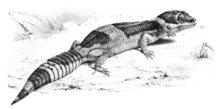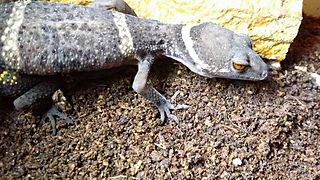
The leopard gecko or common leopard gecko is a ground-dwelling lizard native to the rocky dry grassland and desert regions of Afghanistan, Iran, Pakistan, India, and Nepal. The leopard gecko has become a popular pet, and due to extensive captive breeding it is sometimes referred to as the first domesticated species of lizard.

Craspedocephalus strigatus, commonly known as the horseshoe pit viper, is a venomous pitviper endemic to the Western Ghats of India. No subspecies are currently recognized.

The East Indian leopard gecko, also known commonly as Hardwicke's gecko, is a species of gecko, a lizard in the family Eublepharidae. The species is endemic to India and Bangladesh.

Altiphylax stoliczkai, also known commonly as the frontier bow-fingered gecko, the Baltistan gecko, and the Karakorum gecko is a species of lizard in the family Gekkonidae. The species is endemic to South Asia.
Beddome's day gecko is a species of lizard in the family Gekkonidae. The species is endemic to India.
Cnemaspis otai, also known commonly as Ota's day gecko or the Vellore day gecko, is a species of lizard in the family Gekkonidae. The species is endemic to southeastern India.

Cyrtodactylus collegalensis, also known as the Kollegal ground gecko or forest spotted gecko, is a species of gecko found in and around Mysore hills, at the junction of the Western Ghats and the Eastern Ghats, in South India. Recent taxonomic works and genetic studies revealed that the formerly-supposed genus is actually a subgenus of the widespread genus Cyrtodactylus. It is often confused with the forest spotted gecko.

Cyrtodactylus deccanensis, also commonly known as Deccan ground gecko, Günther's Indian gecko, or the banded ground gecko, is a species of gecko found in the northern Western Ghats of India. It has been found from northern Maharashtra, with a habitat range possibly extending to southern Gujarat. Cyrtodactylus albofasciatus was previously considered conspefic with Cyrtodactylus deccanensis but is now accepted as a valid species.
The Sikkimese bent-toed gecko is a species of gecko found in Darjeeling, India.
Dravidogecko anamallensis, also known as the Anamalay gecko, Anaimalai dravidogecko, or Anamalai Hill gecko, is a species of gecko found in the South Indian hills of Palni, Anamalai and Tirunelveli. It is assigned to the genus Dravidogecko, with a resurrection in 2019, as a study suggested molecular phylogenetics is to have had a separate origin from the other Hemidactylus species.

Hemidactylus prashadi, also known commonly as the Bombay leaf-toed gecko or Prashad's gecko, is a species of lizard in the family Gekkonidae. The species is endemic to the Western Ghats of India.

Ophisops beddomei, commonly known as Beddome's snake-eye or Beddome’ s lacerta, is a species of lizard in the family Lacertidae. The species is a diurnal and fast-moving terrestrial lizard, which is endemic to the Western Ghats of India.
Vosmer's writhing skink is a species of skink, a lizard in the family Scincidae. The species is endemic to India.

Eutropis trivittata is a species of skink found in India.

Lichtenfelder's gecko is a species of lizard in the family Eublepharidae. The species is endemic to southeastern Asia.

Cyrtodactylus albofasciatus, also known as Boulenger's Indian gecko or Deccan banded gecko, is a species of gecko. It is endemic to the Western Ghats, India. It was resurrected from synonymy of Cyrtodactylus deccanensis in 2004.
The Gujarat gecko is a species of gecko. It is endemic to India.
Treutler's gecko is a species of lizard in the family Gekkonidae. The species is endemic to India.

Missone's spider gecko, also known commonly as de Witte's gecko, de Witte's spider gecko, Misonne's swollen-nose gecko, and Witte's gecko, is a species of lizard in the family Gekkonidae. The species is native to Western Asia.
Kaestlea beddomii, also known commonly as Beddome's ground skink, is a species of lizard in the family Scincidae. The species is endemic to the Western Ghats of India.













